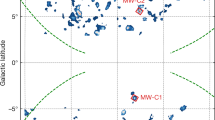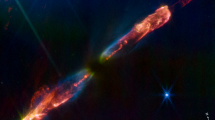Abstract
The loss of mass from protostars, in the form of a jet or outflow, is a necessary counterpart to protostellar mass accretion1,2. Outflow ejection events probably vary in their velocity and/or in the rate of mass loss. Such ‘episodic’ ejection events3 have been observed during the class 0 protostellar phase (the early accretion stage)4,5,6,7,8,9,10, and continue during the subsequent class I phase that marks the first one million years of star formation11,12,13,14. Previously observed episodic-ejection sources were relatively isolated; however, the most common sites of star formation are clusters15. Outflows link protostars with their environment and provide a viable source of the turbulence that is necessary for regulating star formation in clusters3, but it is not known how an accretion-driven jet or outflow in a clustered environment manifests itself in its earliest stage. This early stage is important in establishing the initial conditions for momentum and energy transfer to the environment as the protostar and cluster evolve. Here we report that an outflow from a young, class 0 protostar, at the hub of the very active and filamentary Serpens South protostellar cluster16,17,18, shows unambiguous episodic events. The 12C16O (J = 2−1) emission from the protostar reveals 22 distinct features of outflow ejecta, the most recent having the highest velocity. The outflow forms bipolar lobes—one of the first detectable signs of star formation—which originate from the peak of 1-mm continuum emission. Emission from the surrounding C18O envelope shows kinematics consistent with rotation and an infall of material onto the protostar. The data suggest that episodic, accretion-driven outflow begins in the earliest phase of protostellar evolution, and that the outflow remains intact in a very clustered environment, probably providing efficient momentum transfer for driving turbulence.
This is a preview of subscription content, access via your institution
Access options
Subscribe to this journal
Receive 51 print issues and online access
$199.00 per year
only $3.90 per issue
Buy this article
- Purchase on Springer Link
- Instant access to full article PDF
Prices may be subject to local taxes which are calculated during checkout



Similar content being viewed by others
References
Norman, C. & Silk, J. Clumpy molecular clouds—a dynamic model self-consistently regulated by T Tauri star formation. Astrophys. J. 238, 158–174 (1980)
Shu, F. H., Adams, F. C. & Lizano, S. Star formation in molecular clouds—observation and theory. Annu. Rev. Astron. Astrophys. 25, 23–81 (1987)
Frank, A. et al. in Protostars and Planets VI (eds Beuther, H. et al. ) 451–474 (Univ. Arizona, 2014)
Gueth, F. & Guilloteau, S. The jet-driven molecular outflow of HH 211. Astrophys. J. 343, 571–584 (1999)
Lee, C.-F., Mundy, L. G., Reipurth, B., Ostriker, E. C. & Stone, J. M. CO outflows from young stars: confronting the jet and wind models. Astrophys. J. 542, 925–945 (2000)
Lee, C.-F. et al. HH 212: submillimeter array observations of a remarkable protostellar jet. Astrophys. J. 659, 499–511 (2007)
Lee, C.-F. et al. Submillimeter arcsecond-resolution mapping of the highly collimated protostellar jet HH 211. Astrophys. J. 670, 1188–1197 (2007)
Santiago-Garcia, J., Tafalla, M., Johnstone, D. & Bachiller, R. Shells, jets, and internal working surfaces in the molecular outflow from IRAS 04166+2706. Astrophys. J. 495, 169–181 (2009)
Hirano, N. et al. Extreme active molecular jets in L1448C. Astrophys. J. 717, 58–73 (2010)
Loinard, L. et al. ALMA and VLA observations of the outflows in IRAS 16293–2422. Mon. Not. R. Astron. Soc. 430, L10–L14 (2013)
Cabrit, S. & Raga, A. Theoretical interpretation of the apparent deceleration in the HH 34 superjet. Astrophys. J. 354, 667–673 (2000)
Goodman, A. A. & Arce, H. G. PV Cephei: young star caught speeding? Astrophys. J. 608, 831–845 (2004)
Ioannidis, G. & Froebrich, D. YSO jets in the galactic plane from UWISH2—II. Outflow luminosity and length distributions in Serpens and Aquila. Mon. Not. R. Astron. Soc. 425, 1380–1393 (2012)
Arce, H. G. et al. ALMA observations of the HH 46/47 molecular outflow. Astrophys. J. 774, 39 (2013)
Lada, C.-J. & Lada, E. A. Embedded clusters in molecular clouds. Mon. Not. R. Astron. Soc. 41, 57–115 (2003)
Gutermuth, R. A. et al. The Spitzer Gould belt survey of large nearby interstellar clouds: discovery of a dense embedded cluster in the Serpens-Aquila Rift. Astrophys. J. 673, L151–L154 (2008)
Tanaka, T. et al. The dynamical state of the Serpens South filamentary infrared dark cloud. Astrophys. J. 778, 34 (2013)
Nakamura, F. et al. Cluster formation triggered by filament collisions in Serpens South. Astrophys. J. 791, L23 (2014)
Dzib, S. et al. VLBA determination of the distance to nearby star-forming regions. IV. A preliminary distance to the proto-Herbig AeBe star EC 95 in the Serpens core. Astrophys. J. 718, 610–619 (2010)
Kirk, H. et al. Filamentary accretion flows in the embedded Serpens South protocluster. Astrophys. J. 766, 115–128 (2013)
Plunkett, A. L. et al. Assessing molecular outflows and turbulence in the protostellar cluster Serpens South. Astrophys. J. 803, 22 (2015)
Nakamura, F. et al. Molecular outflows from the protocluster Serpens South. Astrophys. J. 737, 56 (2011)
Raga, A. C., Binette, L., Canto, J. & Calvet, N. Stellar jets with intrinsically variable sources. Astrophys. J. 364, 601–610 (1990)
Suttner, G., Smith, M. D., Yorke, H. W. & Zinnecker, H. Multi-dimensional numerical simulations of molecular jets. Astron. Astrophys. 318, 595–607 (1997)
Smith, M. D., Suttner, G. & Yorke, H. W. Numerical hydrodynamic simulations of jet-driven bipolar outflows. Astron. Astrophys. 323, 223–230 (1997)
Audard, M. et al. in Protostars and Planets VI (eds Beuther, H. et al. ) 387–410 (Univ. Arizona, 2014)
Raga, A. C., Velázquez, P. F., Cantó, J. & Masciadri, E. The time-dependent ejection velocity histories of HH 34 and HH 111. Astrophys. J. 395, 647–656 (2002)
Teixeira, G. D. C., Kumar, M. S. N., Bachiller, R. & Grave, J. M. C. Molecular hydrogen jets and outflows in the Serpens South filamentary cloud. Astrophys. J. 543, A51 (2012)
Oya, Y. et al. A substellar-mass protostar and its outflow of IRAS 15398–3359 revealed by subarcsecond-resolution observations of H2CO and CCH. Astrophys. J. 795, 152 (2014)
Lee, C.-F. et al. ALMA results of the pseudodisk, rotating disk, and jet in the continuum and HCO+ in the protostellar system HH 212. Astrophys. J. 786, 114 (2014)
Acknowledgements
A.L.P. is supported by a National Science Foundation (NSF) Graduate Research Fellowship under grant DGE-1122492; this research was made possible by the US Student Program of Fulbright Chile. H.G.A. receives funding from the NSF under grant AST-0845619. D.M. acknowledges support from CONICYT project PFB-06. M.M.D. acknowledges support from the Submillimeter Array through a postdoctoral fellowship. ALMA is a partnership of the European Space Organization (ESO, representing its member states), NSF (USA) and National Institutes of Natural Sciences (Japan), together with the National Research Council (Canada) and National Security Council and Academia Sinica Institute of Astronomy and Astrophysics (Taiwan), in cooperation with the Republic of Chile. The Joint ALMA Observatory is operated by ESO, Associated Universities Inc. (AUI)/National Radio Astronomy Observatory (NRAO) and National Astronomical Observatory of Japan. The NRAO is a facility of the NSF, operated under cooperative agreement by AUI. This paper makes use of the following ALMA data: ADS/JAO.ALMA 2012.1.00769.S.
Author information
Authors and Affiliations
Contributions
A.L.P. led the proposal, observations, analysis and interpretation, and wrote the manuscript. H.G.A. contributed to the analysis and interpretation, and to the manuscript. A.L.P., H.G.A., D.M., M.M.D., J.G. and S.A.C. planned the early stages of the project. D.M., M.M.D., M.F.-L. and J.G. contributed to the analysis and interpretation and commented on the manuscript. P.v.D. contributed to the interpretation and to the manuscript.
Corresponding authors
Ethics declarations
Competing interests
The authors declare no competing financial interests.
Extended data figures and tables
Extended Data Figure 1 C18O emission from the protostellar source C7.
Top row, blueshifted emission; bottom row, redshifted emission; velocity increases from left to right. Contours begin at 4σ and increment by 4σ. Specific velocity ranges (|VLSR − Vc|, or velocity relative to cloud velocity) are given for each column. Each panel shows integrated emission from two channels. The location of peak continuum emission is marked with a magenta cross.
Extended Data Figure 2 1-mm continuum emission near the sources CARMA-7 (RA = 18 h 30 min 04.1 s, dec. = −02° 03′ 02.6″) and CARMA-6 (RA = 18 h 30 min 03.5 s, dec. = −02° 03′ 08.4″).
Contours show 10σ, 30σ, 50σ and 70σ, followed by increments of 50σ. Near these strong sources, we find the r.m.s. noise to be 0.3 mJy beam−1.
Extended Data Figure 3 Cartoon depiction of a protostellar system, showing the outflow (12CO emission), envelope (C18O emission) and disk (unresolved).
Contributions to blueshifted and redshifted molecular line emission are indicated along the outflow and envelope, assuming that the outflow is nearly in the plane of the sky with respect to the observer.
Rights and permissions
About this article
Cite this article
Plunkett, A., Arce, H., Mardones, D. et al. Episodic molecular outflow in the very young protostellar cluster Serpens South. Nature 527, 70–73 (2015). https://doi.org/10.1038/nature15702
Received:
Accepted:
Published:
Issue Date:
DOI: https://doi.org/10.1038/nature15702
This article is cited by
-
Binarity of a protostar affects the evolution of the disk and planets
Nature (2022)
-
Molecular jets from low-mass young protostellar objects
The Astronomy and Astrophysics Review (2020)
Comments
By submitting a comment you agree to abide by our Terms and Community Guidelines. If you find something abusive or that does not comply with our terms or guidelines please flag it as inappropriate.



